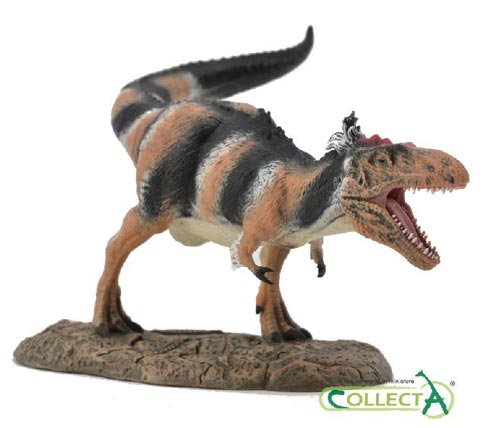A Review of the CollectA Bistahieversor Model
The CollectA Bistahieversor Model Reviewed
New for 2014 from CollectA in their not-to-scale prehistoric animal model series is this replica of Bistahieversor (pronounced Bis-tar-hee-eh-ver-sore), a member of the tyrannosaur family from New Mexico and distantly related to the much more famous T. rex this is Everything Dinosaur’s review of this dinosaur replica.
The CollectA Bistahieversor Dinosaur Model
Picture credit: Everything Dinosaur
Bistahieversor sealeyi
During the Late Cretaceous much of North America was covered by a huge sea. This was called the Western Interior Seaway and it stretched from what is now the Arctic Ocean in the north to the Gulf of Mexico in the south. The landmasses that bordered this inland sea were dominated by dinosaurs and what scientists are now recognising is that despite the mix of dinosaurs in the north and the south being very similar – ceratopsians, Lambeosaurines, ankylosaurids, tyrannosaurids and so forth, the genera and species making up those faunas differed markedly across North America.
What you have is distinct regional ecosystems. What we term “provinciality” and you can explore lots of articles about this on the Everything Dinosaur web log.
To read an article about the regional diversity of horned dinosaurs in North America: A Surge in Mountain Building May Have Led to Dinosaur Diversification.
Bistahieversor fossils come from the oldest part of the Kirtland Formation, exposed in New Mexico, strata dating to around 74.5 million years ago. Isolated teeth very typical of a large tyrannosaur had been found for many years and these were thought to represent types of tyrannosaur known from fossilised bones found in Montana and Alberta (Canada) in the north.
Dinosaur Skull
A partial skull found in 1990 was associated with tyrannosaur fossil material from Montana, (potentially Daspletosaurus), but gradually as more body fossils were discovered in this part of the San Juan Basin, it was realised that these fossils represented the remains of a distinct southern genus of tyrannosaurid. Following a review in 2010, the genus Bistahieversor (B. sealeyi) was established.
The name means “Bistahi Destroyer”, the genus honours the local Navajo indian population, the word “Bisti” means “place of the adobe formations” in the local dialect. The trivial name honours museum volunteer Paul Sealey, who found the fossils of an adult animal in 1997.
CollectA Bistahieversor Dinosaur Model
The CollectA model stands on a base, it is the second , large tyrannosaur model in the not-to-scale series to be placed on a base, the first being the modified T. rex with prey replica. It is a very striking pose, the skin texture has been finished to give the impression of a shaggy, feathery coat. Here is a model of a feathered tyrannosaur reflecting the very latest in theropd interpretation and part of a trend for more feathered dinosaur models, which we know is going to continue into 2015 and beyond.
The body proportions are based on what is known from the fossil material, particularly the adult specimen discovered in 1997, by Paul Sealey. The skull sports a distinctive cranial crest and this has been further augmented by the model makers with the addition of a tuft of shaggy, black and white proto-feathers. The crest on the skull may have been synonymous with a mature adult animal as no evidence for a crest was found on the fossilised skull of a juvenile which was discovered two years earlier (1995).
Like all the CollectA replicas, this is a beautiful model with a well-crafted paint regime consisting of tawny, black and white stripes which contrast nicely with the cream coloured belly. Even the base has lots of detail, the feet seem to sink into the base to give the impression of a heavy animal walking across soft sand.
A Model of a Tyrannosaur Named in 2010
Picture credit: Everything Dinosaur
This model measures around 13 cm in length. Based on an adult animal being around 8.5 metres we estimate that this replica is in approximately 1:65 scale. The powerful animal with its strong tail and robust skull probably weighed around 2.5 tonnes and it was very likely the apex predator in the coastal plain habitat found to the south of the Western Interior Seaway.
This is a beautifully crafted, hand-painted replica of Bistahieversor, a dinosaur that was only named and scientifically described back in 2010. It is an exciting addition to the CollectA range of prehistoric animal models and it is great to see more tyrannosaurids represented, especially feathered ones.
To view Everything Dinosaur’s range of CollectA prehistoric animal models: CollectA Prehistoric Life Dinosaur Models.



